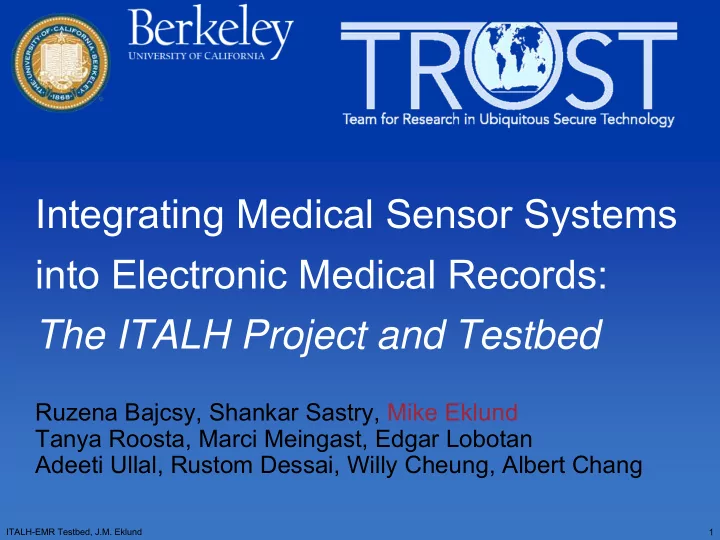

Integrating Medical Sensor Systems into Electronic Medical Records: The ITALH Project and Testbed Ruzena Bajcsy, Shankar Sastry, Mike Eklund Tanya Roosta, Marci Meingast, Edgar Lobotan Adeeti Ullal, Rustom Dessai, Willy Cheung, Albert Chang ITALH-EMR Testbed, J.M. Eklund 1
The issue: Rising Healthcare Costs • According to the National Coalition on Health Care, total health care expenditures in 2003: • Increased by 7.7 % – four times the rate of inflation • To $1.7 trillion – Projected at $2.1 trillion in 2006 and $3.8 trillion in 2015 • Which was 15.3 % of (GDP) – It is projected that the percentage will reach 19.0 % by 2015. 2002 2050 Percentage of Population Percentage of Population over 6 0 years old over 6 0 years old Global Average = 1 0 % Global Average = 2 1 % Table compiled by the U.S. Administration on Aging based on SOURCE: United Nations ▪ “Population Aging ▪ 2002” data from the U.S. Census Bureau. ITALH-EMR Testbed, J.M. Eklund 2
How can we handle this? • Group care facilities are very expensive • Monetary cost to – The individual and their family – And/or the social welfare system • Health/happiness cost – Leaving ones home is often difficult or even traumatic. • The goal of ITALH is: • to keep people healthy and happy at home if possible, • and thus avoid having moving them to more intensive care facilities ITALH-EMR Testbed, J.M. Eklund 3
The ITALH System Integration into Electronic Individual sensor Medical Records system development Sensor and data fusion, communication issues ITALH-EMR Testbed, J.M. Eklund 4
The ITALH team Finland (Tekes, VTT, TUT) An international collaboration unified through institutional agreements, and tied together by Denmark (Aarhus) societal interests. USA (Berkeley, TRUST) Telecom Italia ITALH-EMR Testbed, J.M. Eklund 5
Integration of sensor systems to EMRs • Biomedical sensor systems • Can monitor for acute and chronic conditions and emergency events • Is it necessary to store the data in an EMR? • Is it useful to do so? Would it provide medical benefit? ITALH-EMR Testbed, J.M. Eklund 6
What are the possible benefits of including this data in an EMR? • Currently entry requires manual intervention by health care provider • Most data is not used nor stored for analysis • Could provide significant diagnostic ability, and improved care • E.g. for osteoporosis, where a clear negative correlation has been shown between activity level and bone density loss • E.g., currently, pre- and post-operative evaluations are at best snap-shots of the patients conditions ITALH-EMR Testbed, J.M. Eklund 7
Traditional Telemedicine • Telemedicine is a technology-rich alternative to a traditional face-to-face physician consultation. Physician Station Patient Station Courtesy Dr. Richard Re, Ochsner Clinic • Telemedicine remains a one-to-one activity, more convenient of course ITALH-EMR Testbed, J.M. Eklund 8
Current Devices and Systems • E.g., Honeywell HomMed Products • http://www.hommed.com • Telemedicine applications Spirometer PT/INR Peak Flow/FEV1 ECG Blood Glucose Oximeter ITALH-EMR Testbed, J.M. Eklund 9
ITALH-EMR Testbed Project • ITALH’s primary purpose is to enable improved self- care by • Providing preventive tools • Improving safety, security, monitoring, at home • Enabling technology cooperation, delivery of services • ITALH differs from related efforts in that it aims to automate much of the monitoring and alerting • Drastically reduce the amount of care required to provide the same level of care • And to make it ubiquitous through wireless and embedded technology • Automation must also be thought of in term of EMRs and healthcare providers ITALH-EMR Testbed, J.M. Eklund 10
ITALH/EMR Development • Protocols and policies must be established for the inclusion of automated data collection • This will be integrated with the Vanderbilt myHealth system following initial Home system development Mobile system • And Telecom Italia test bed Healthcare provider/EMR: myHealth • A test system is being developed to integrate openEMed Physician Client the ITALH testbed with an ITALH/openEMed Client openEMed Server open source EMR system • Using volunteers in Sonoma ITALH-EMR Testbed, J.M. Eklund 11
ITALH Initial focus and secondary results • Initial focus of sensor development: Fall Detection • Falls are the leading cause of fatal and nonfatal injuries to older people in the U.S. • Each year, more than 11 million people over 65 fall – one of every three senior citizens • Treatment of the injuries and complications associated with these falls costs the U.S. over 20 billion annually • Secondary information that has resulted: • The devices reveal additional information about the user • This provides significant opportunities for health monitoring • It also creates a potential threat to the users privacy ITALH-EMR Testbed, J.M. Eklund 12
Identification of Activities of Daily Living • Being able to measure and analyze a patients activity, enables: • Rapid and automated response to critical and emergency situations • Activity of Daily Living Identification: • Sitting, • standing, • Walking • Implications? • Benefits? ITALH-EMR Testbed, J.M. Eklund 13
Implications • The potential of such systems can only be realized on a societal scale if such devices can be integrated in the EMR systems, so that: • Data acquisition is at least semi-autonomous • The data can be guaranteed to be accurate • The system is secure • What does Security mean? • We must be able to assure the user of their privacy – Not limited to medical information • We must be able to assure data integrity • Other considerations: what if they withhold or provide false information? ITALH-EMR Testbed, J.M. Eklund 14
Conclusions • Through the TRUST EMR Project • Developing a testbed and protocols for directly including sensor data in EMRs • Integrating into open source EMR system locally • Will implement policy and access control, and model-based approaches • Communications issues with telecom providers • Plan to integrate into VUMC myHealth system • The goal is to enable live, automated medical record entry from sensor systems • Home based at first • Clinical applications later ITALH-EMR Testbed, J.M. Eklund 15
Recommend
More recommend